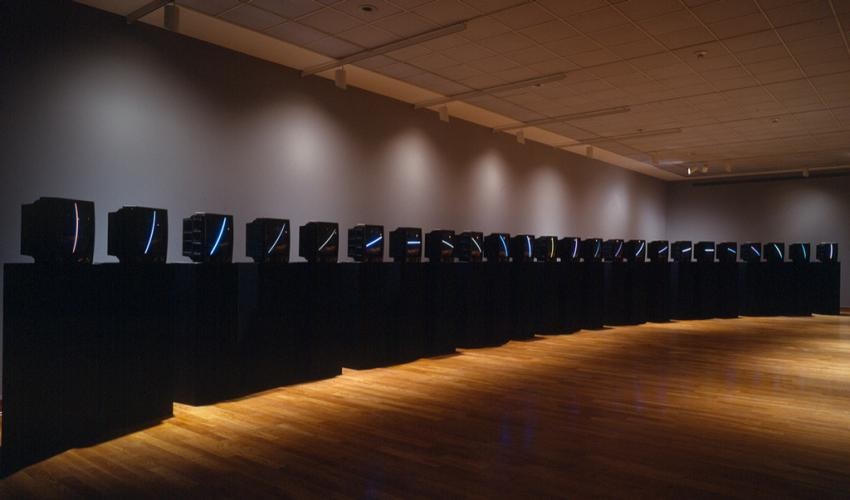
Nam June Paik
Korean, 1932-2006 (active USA)
TV Clock, 1963 (1989 version)
twenty-four fixed-image color television monitors mounted on twenty-four pedestals; color and black-and-white, silent
21 x 15 3/4 x 19 in. each television
SBMA, Museum purchase with funds provided by H. Smith Richardson III and the Grace Jones Richardson Trust, Lillian and Jon B. Lovelace, Leatrice and Eli Luria and the Luria Foundation, Zora and Les Charles and the Cheeryble Foundation, Wendy and Elliot Friedman, and Lord and Lady Ridley-Tree
1999.33a-x

Nam June Paik in 1976 installing Fish Flies on the Sky at Galeria Bonino in New York City.
COMMENTS
Nam June Paik, who studied aesthetics and music in Japan and then participated in "Fluxus" performances in Europe in the early 1960s, is widely acknowledged as a primary innovator of video art. In 1963 he altered the signals on black and white televisions for his Zen for TV sculptures, each with a single fixed image, a line of light on the dark screen.
Paik’s "TV Clock" (1963/89) was initially part of these experiments, and then was remade with color televisions. In this installation of 24 monitors on pedestals arranged in a 40-foot arc, he compressed the red, green, and blue colors into a single static white line on each screen, to represent one of the twenty-four hours of the day. The glowing white lines appear in a temporal sequence like the hands on a clock or the linear shadows on a sundial, and move dynamically across the arc of black screens, as the monitors disappear into darkness. While they are “drawn” with electronics, these spare, singular lines also reference concurrent minimalist works in other media, such as Barnett Newman’s horizontal and vertical “zips,” Agnes Martin’s painted pin stripes, and Dan Flavin’s fluorescent tube sculptures.
Eventually, all of these white lines will slowly shift and move out of register. At some unknown future date, the television tubes will no longer function—the lines will gradually morph into ghost-like traces, then entirely disappear from the screen. "TV Clock," therefore, becomes a memento mori, reminding us how the material eventually becomes immaterial, time after time.
- Karen Moss, Curator in Residence and Adjunct Professor, Otis College of Art and Design, Los Angele, 75th Anniversary Catalog
The hour struck! Diana du Pont, SBMA curator of modern and contemporary art, had kept her eye on "TV Clock," a pivotal work by the groundbreaking video artist Nam June Paik; with the news that it was available, du Pont lost no time. She quickly arranged for the piece to be shipped to Santa Barbara and installed in the Museum so that it could be considered for purchase by prospective patrons.
A room-sized installation, TV Clock consists of 24 color television monitors mounted upright on pedestals arranged in a gentle arc and displayed in a darkened space. Paik manipulated each television's moving image by compressing its red, green, and blue colors into a single, static line against a black background. They are "fixed image televisions," as Paik explains, and do not involve videotapes, laser disks, or computer chips, but rather the ingenious reworking by hand of the TV's interior mechanisms. The installation's reductive beauty parallels 1960s Minimalist paintings and sculptures by such artists as Donald Judd, Ellsworth Kelly and Dan Flavin. The work's rhythmic structure suggests a sundial or the hands of a clock; its overall shape and simplified, block-like forms are reminiscent of the prehistoric monument Stonehenge, while the electric radiance of Paik's TVs evokes the modern media age.
- The Right Time, SBMA View, May/June 2000, p. 13.
SBMA CURATORIAL LABELS
Innovative and prophetic, Nam June Paik (1932-2006) blazed a trail uniting art and electronics that remains influential to this day. One of the Santa Barbara Museum of Art’s most important works of media art, Paik’s TV Clock first appeared at SBMA in 2000 as part of the exhibition Nam June Paik: Video Art Pioneer, and is on view here for the first time in nearly a decade.
TV Clock consists of 24 color televisions side-mounted on pedestals arranged in a long gentle arc. Paik created each image by compressing the TV’s red, green and blue color system into a single line of light against a black background. Viewed in sequence, these bright lines form a dynamic yet spare linear rhythm resembling hands on a 24-hour clock face.
In this and many similar works, Paik reconfigured the kind of ordinary TV sets that by the late 1950s had become embedded in homes around the world. Born in Korea and raised partly in Japan, Paik initially studied music in Tokyo and then in West Germany. In the early 1960s, Paik would meet many of the artists who founded Fluxus. This radically avant-garde group sought to eliminate boundaries between art and life via performances, film, poetry, sculpture and installations, all of which adopted and transformed everyday situations, language and objects. Paik zeroed in on the TV, subverting its usual function to entertain, inform or persuade by manipulating the ways a TV’s cathode ray tube creates and transmits images.
Paik’s installations brought about a new awareness of electronic media’s seemingly infinite power in contemporary society, while also addressing more abstract, sometimes metaphysical themes of time, light and space, as seen in this commanding yet contemplative installation. Pivotal in Paik’s long career, TV Clock’s original version was made in 1963, the year Paik first used TVs, and offers viewers the chance to experience the revolutionary work and thought of one of the 20th century’s most innovative and enduringly relevant artists.
- Nam June Paik: TV Clock, 2018
